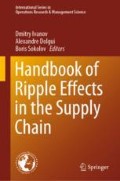Abstract
Modern supply chains have become increasingly complex and interconnected, raising concerns as to the potential loss of system-wide resilience. One distinct element of supply chain risk is the potential for detrimental material to propagate through the supply chain undetected, eventually exposing unsuspecting consumers to defective products. In this chapter, based on methods inspired by epidemiology, we propose new measures for quantifying this risk. We then apply these measures to real-life supply networks from eight industries to compare their relative levels of risk across a 17-year time horizon. Our results indicate that while in aggregate supply chain risk has increased overtime, both the level and sources of risk differ markedly by industry.
Access this chapter
Tax calculation will be finalised at checkout
Purchases are for personal use only
References
Ahuja, G. (2000). Collaboration networks, structural holes, and innovation: A longitudinal study. Administrative Science Quarterly, 45(3), 425–455.
Basole, R. C., & Bellamy, M. A. (2014a). Visual analysis of supply network risks: Insights from the electronics industry. Decision Support Systems, 67, 109–120.
Basole, R. C., & Bellamy, M. A. (2014b). Supply network structure, visibility, and risk diffusion: A computational approach. Decision Sciences, 45(4), 753–789.
Basole, R. C., Bellamy, M. A., Park, H., & Putrevu, J. (2016). Computational analysis and visualization of global supply network risks. IEEE Transactions on Industrial Informatics, 12(3), 1206–1213.
Battiston, S., Gatti, D. D., Gallegati, M., Greenwald, B., & Stiglitz, J. E. (2007). Credit chains and bankruptcy propagation in production networks. Journal of Economic Dynamics and Control, 31(6), 2061–2084.
Bellamy, M. A., Ghosh, S., & Hora, M. (2014). The influence of supply network structure on firm innovation. Journal of Operations Management, 32(6), 357–373.
Carnovale, S., & Yeniyurt, S. (2014). The role of ego networks in manufacturing joint venture formations. Journal of Supply Chain Management, 50(2), 1–17.
Carnovale, S., & Yeniyurt, S. (2015). The role of ego network structure in facilitating ego network innovations. Journal of Supply Chain Management, 51(2), 22–46.
Choi, T. Y., Dooley, K. J., & Rungtusanatham, M. (2001). Supply networks and complex adaptive systems: Control versus emergence. Journal of Operations Management, 19(3), 351–366.
Choi, T., & Hong, Y. (2002). Unveiling the structure of supply networks: Case studies in Honda, Acura, and DaimlerChrysler. Journal of Operations Management, 20, 469–493.
De Stefano, M. C., & Montes-Sancho, M. J. (2018). Supply chain environmental R&D cooperation and product performance: Exploring the network dynamics of positional embeddedness. Journal of Purchasing and Supply Management. https://doi.org/10.1016/j.pursup.2018.10.003.
Dolgui, A., Ivanov, D., & Sokolov, B. (2018). Ripple effect in the supply chain: An analysis and recent literature. International Journal of Production Research, 56(1-2), 414–430.
Dong, M., Liu, Z., Yu, Y., & Zheng, J. (2015). Opportunism in distribution networks: The role of network embeddedness and dependence. Production and Operations Management, 24(10), 1657–1670.
Gai, P., & Kapadia, S. (2010). Contagion in financial networks. In Proceedings of the Royal Society of London A: Mathematical, Physical and Engineering Sciences, p. rspa20090410.
Grewal, R., Lilien, G. L., & Mallapragada, G. (2006). Location, location, location: how network embeddedness affects project success in open source systems. Management Science, 52(7), 1043–1056.
Hethcote, H. (2000). The mathematics of infectious diseases. SIAM Review, 42(4), 599–653.
Kermack, W., & McKendrick, A. (1927). Contributions to the mathematical theory of epidemics. In Proceedings of the Royal Society London Ser. A, Vol. 115(772), pp. 700–721.
Kim, Y., Chen, Y.-S., & Linderman, K. (2015). Supply network disruption and resilience: A network structural perspective. Journal of Operations Management, 33–34, 43–59.
Kim, Y. H. (2017). The effects of major customer networks on supplier profitability. Journal of Supply Chain Management, 53(1), 26–40.
Mazzola, E., Perrone, G., & Kamuriwo, D. S. (2015). Network embeddedness and new product development in the biopharmaceutical industry: The moderating role of open innovation flow. International Journal of Production Economics, 160, 106–119.
Miller, R. (1962). How to plan and control with PERT. Harvard Business Review, 40(2), 93–104.
Pathak, S. D., Day, J. M., Nair, A., Sawaya, W. J., & Kristal, M. M. (2007). Complexity and adaptivity in supply networks: Building supply network theory using a complex adaptive systems perspective*. Decision Sciences, 38(4), 547–580.
Phelps, C. C. (2010). A longitudinal study of the influence of alliance network structure and composition on firm exploratory innovation. Academy of Management Journal, 53(4), 890–913.
Sokolov, B., Ivanov, D., Dolgui, A., & Pavlov, A. (2016). Structural quantification of the ripple effect in the supply chain. International Journal of Production Research, 54(1), 152–169.
Yoo, E., Rand, W., Eftekhar, M., & Rabinovich, E. (2016). Evaluating information diffusion speed and its determinants in social media networks during humanitarian crises. Journal of Operations Management, 45, 123–133.
Author information
Authors and Affiliations
Corresponding author
Editor information
Editors and Affiliations
Rights and permissions
Copyright information
© 2019 Springer Nature Switzerland AG
About this chapter
Cite this chapter
Minas, J.P., Simpson, N.C., Kao, TW. (2019). New Measures of Vulnerability Within Supply Networks: A Comparison of Industries. In: Ivanov, D., Dolgui, A., Sokolov, B. (eds) Handbook of Ripple Effects in the Supply Chain. International Series in Operations Research & Management Science, vol 276. Springer, Cham. https://doi.org/10.1007/978-3-030-14302-2_11
Download citation
DOI: https://doi.org/10.1007/978-3-030-14302-2_11
Published:
Publisher Name: Springer, Cham
Print ISBN: 978-3-030-14301-5
Online ISBN: 978-3-030-14302-2
eBook Packages: Business and ManagementBusiness and Management (R0)

